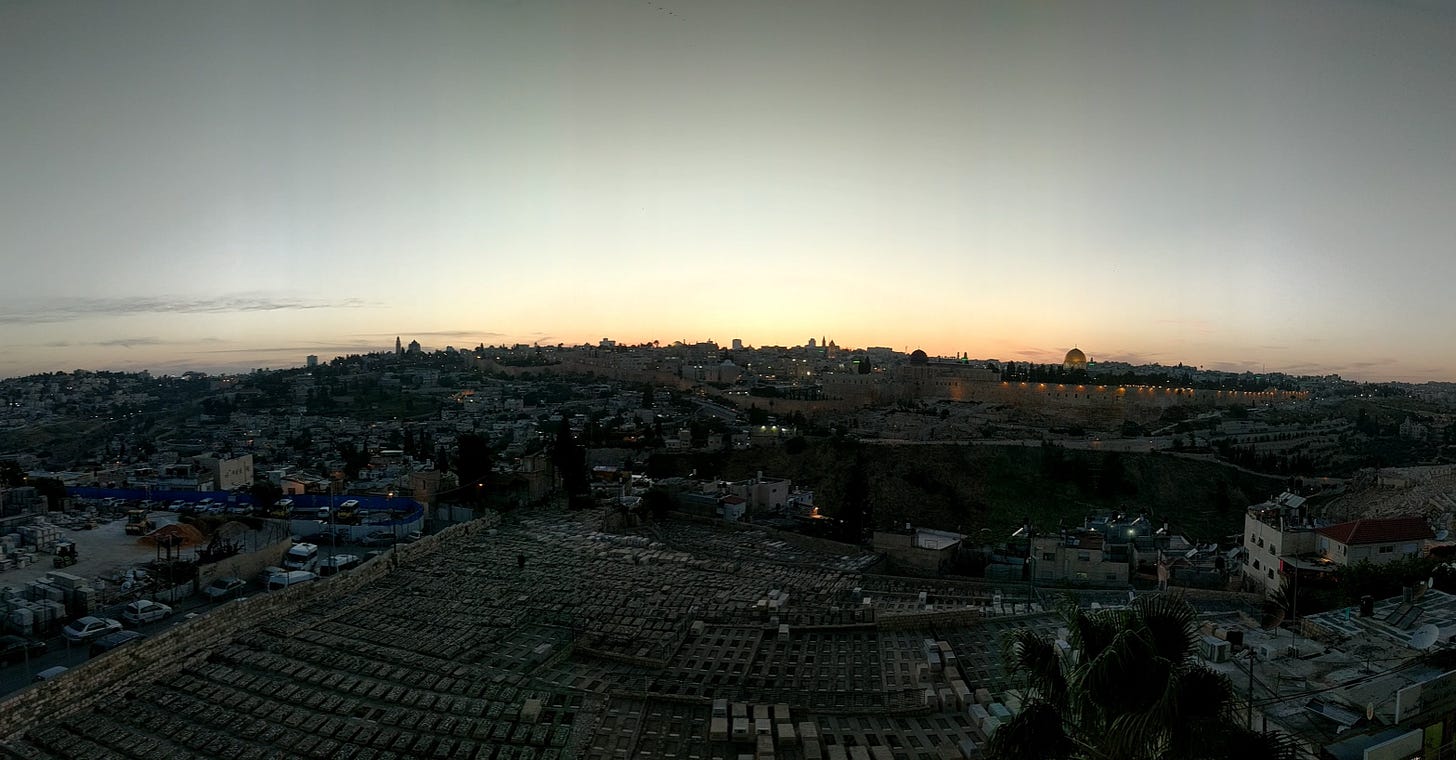Roughly five years ago, my little tour group snuck out to a hill overlooking Bethlehem after nightfall (our guide did not find Bethlehem very welcoming). It was chilly for early spring, so we huddled together and peered out at the darkened landscape below. Unsurprisingly, our thoughts turned to the very first Christmas as we quietly sang and reflected on the birth of a truly remarkable person: Jesus Christ.
The scene was as one of my favorite hymns noted—very still. A sacred darkness seemed to envelop the city and the whole surroundings. O Little Town of Bethlehem was written by Reverend Phillip Brooks in 1868 after his own visit to Bethlehem a few years prior. He penned the solemn, almost melancholy words:
O little town of Bethlehem,
how still we see thee lie!
Above thy deep and dreamless sleep
the silent stars go by.
Yet in thy dark streets shineth
the everlasting light;
the hopes and fears of all the years
are met in thee tonight.

The darkest streets
Bethlehem’s streets were (literally) dark not only in Jesus’ day, or a century-and-a-half-ago when Mr. Brooks visited, or 5 years ago when my little group tried to make out its outline. They may be darker still this year with the ongoing conflict between Israel and Palestine, a heartwrenching war that reminds us of the cruelty our world is capable of.
In the past few months in particular, the “fears of all the years”—the sadnesses, the injustices, the hurt, and the pain, most of it undeserved—keep playing in my mind. It can feel dark.
For many, Christmas and the holidays seem to exacerbate their wounds. I know some of my loved ones are struggling after a miscarriage, a smarting divorce, years of unfruitful job searches, a falling out with their family, or simply another year single without hope of loving companionship. These sorrows can be crushing. At least three people in my acquaintance have lost their tiny babies the week before Christmas (several within hours of my own child’s birth). I cannot think about this except with deep sorrow.
Where is the promise of Christmas in that?
There is so much good out there. But along with so much good, there are also many troubling things afoot. Division. Unrest. Justice denied. Violence applauded and excused by this side or that. Politically, I must admit that I do not look forward to 2025, whether zoomed in on local politics or zoomed out on national and international affairs. Our future too often seems a dark place.
Yet there is light.
The light returns
O Little Town of Bethlehem reminds me that perhaps focusing on the holiday festivities—the jolliness of all the presents and merrymaking and the Hallmark videos—misses the hope and the peace of the season. Maybe the spirit of Christmas is silent and sacred, not loud. The hope of all the years came into the stillness.
Most world religions celebrate light sometime during the darkest months. Christmas for Christians, Hanukkah for Jews, Diwali for Hindus, Ramadan for Muslims. For most of Asia there’s light-filled New Year celebrations. Even pagan sun worshippers are on board, celebrating the winter solstice. Something about the darkness of winter brings the promise of light.
This is literally true: the days are starting to lengthen once again, as the sun shows his face for longer (hooray). Within the darkness of winter, we use candles, wrap trees in lights and decor, and edge rooflines with LEDs. Adding light is serious business for many—our across-the-street neighbors have a truly impressive synchronized Christmas music and light show.
The everlasting light
Those lights are all meaningful (I’m writing this by Home Depot Christmas lights on our tree and bannister) but I think light is even more than a symbol. For Jesus worshippers like myself, His light is stronger still than the physical sun. His light and hope can flood our lives, taking away the sting of even the darkest night and deepest trial.
It’s instructive to me that the everlasting light we celebrate is… a newborn. Several years ago, we brought our firstborn son home in a “swaddle” (okay, a carseat) on Christmas Eve. The sweet purity of newborn babies is breathtaking—and its equally astonishing how utterly helpless newborns are. Birth is trial enough for such a small body! Then these tiny beings are thrust into an often cold, dark, unforgiving world, wholly reliant on others.
Yet Jesus chose to come to earth a tiny babe. He came not only to a destitute refugee1 family, but he entered just as the rest of us did. Completely dependent on his parents and heavenly parents for physical life and sustenance. And somehow, still, this act and this tiny babe represent for Christians the summation of our hopes and fears. He is our everlasting light.
As I wrap this post up the night before Christmas, rocking my own baby back to sleep before midnight, I feel the immense weight of the gift of Jesus’s coming as a little child so many thousands of years ago. In the difficult times and sorrows that surround us, we can remember:
For Christ is born of Mary;
and, gathered all above,
while mortals sleep, the angels keep
their watch of wond'ring love.
O morning stars, together
proclaim the holy birth,
and praises sing to God the King,
and peace to men on earth.
May God send peace to you and yours this holiday season. Whatever your trials, fears, or the darkness that may surround you, my wish for you is that your life be filled with light.
The past few months, I’ve been pondering a lot about Mary, Joseph, and Jesus as refugees. My favorite thoughts on the subject were given back in 2016 in a talk I am always inspired by: “I Was a Stranger.”


